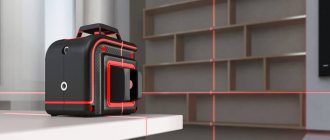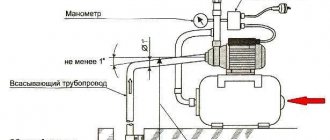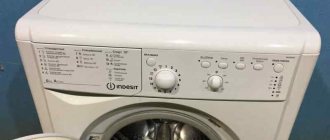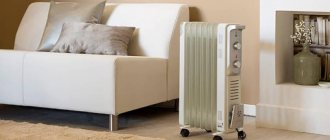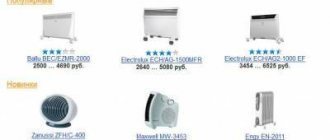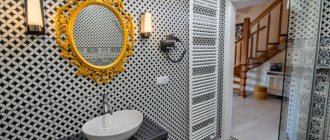Despite their higher cost, vertical heating radiators are gaining popularity. They allow you to organize heating of rooms with a non-standard layout, where it is quite difficult to install horizontal radiators.
This is an excellent solution for rooms with high ceilings of 4 m or more, since vertical structures enhance the convection of warm air to a much greater extent. Sometimes vertical radiators are simply an unusual, attention-grabbing design solution.
Characteristics of a vertical radiator
Vertical equipment is produced from 1 to 3 meters in height and has many similarities with its horizontal counterpart. The batteries are distinguished by their impressive weight and size.
Therefore, in their manufacture, as a rule, cast iron is not involved, otherwise there will be a very strong load on the walls of the room. And you shouldn't expect a unique radiator design.
Minimum required thermal power
Typically, thermal calculations of houses are done infrequently, so calculations have to be done room by room. The power of all radiators should be 20% higher than the power of the boiler. For a house insulated according to GOST, heat loss is 10 kW per 100 sq. m. with a ceiling height of up to 2.7 m.
Determining the number of radiators in each room by area is not always reasonable. Heat loss depends on walls, windows, doors. You shouldn't hang too many batteries either. But there should be enough of them so that the system is not hot (>70°C).
Here is an example of power distribution:
- The inner room is heated by the neighboring ones and can be equipped with a minimum number of radiators.
- External wall and window – 1 kW per 10 m2.
- A long outer wall and two windows - multiply the previous figure by 1.2.
- Two external walls and a window - multiply by 1.3.
- Two external walls and two windows - we multiply the primary data by 1.4 or 1.5.
This definition of power is relative. Much depends on other characteristics of the house: layout, size of external walls and windows. But for more than 90% of standard Russian houses, such a simple calculation is quite enough.
Variety
Vertical radiators are divided into three types according to the material of manufacture.
Bimetallic batteries
They are special in that their tubes and internal channel system are made of steel alloy.
- In this case, the heat fins, which perform the function of radiating heat, are made of aluminum.
- This allows the system to withstand corrosion and transfer heat to the room in full.
- Also, a battery of any design can be created from aluminum alloy, and the color of the radiator can be of any palette.
Since this material can be easily painted and applied to any, even picky interior design. This heating system is distinguished by its high cost.
Steel batteries
Radiators made of steel are rarely found in exquisite design. Mostly, manufacturers offer simple, unpretentious design options. This is explained by the fact that this alloy is difficult to machine.
In addition, this type of battery quickly fails due to its inability to resist corrosion even with an additional protective layer.
Manufacturing sections also have their differences. They are produced in panel design, hiding pipes and channels behind metal. This all justifies the inexpensive cost of this equipment.
Aluminum batteries
This is an ideal option for vertical heating radiators for an apartment. They have a fairly low cost, but the heat transfer power in this case also suffers. They are also lightweight and weak in strength. But they are in high demand among consumers in the heating equipment market.
Advantages of ordering
- Professionalism of specialists. Our employees are ready to install all types of radiators. Masters have the necessary knowledge and skills. It is also important that the installation of vertical batteries is carried out using modern devices and tools.
- Operational problem solving. Installation of any radiator will not take much time. Work of any complexity can be completed by professionals in just a couple of hours. The exact timing of installation of batteries in the heating system can be clarified in advance.
- Advisory support. Our specialists are ready to answer all your questions. They will tell you how and when the heating batteries you have chosen will be installed. Managers will also tell you about the components used.
- Optimal cost of installation of heating radiators. You will not have to overpay for work performed by professionals. Our specialists will announce exact prices before the installation of batteries begins. Thanks to this, you can plan your expenses in advance.
Contact us! Installation of heating radiators at any facility in Moscow will be done efficiently and quickly!
See also:
- cost of installing heating radiators
- installation of radiators in an apartment
- installation of heating radiators in the bathroom
- installation of heating radiators in a private house
- installation of heating radiators on gas welding
- installation of radiators with a guarantee
External feature
Heat transfer in radiators depends on their area. The larger it is, the warmer the room will be. This feature also includes the form of equipment, which is carried out according to the following external features:
- Sectional batteries;
- Tubular radiators;
- Panel batteries.
Sectional batteries
This equipment consists of elongated sectional pipes that are connected at the top and bottom by manifolds. Often the manufacturer produces this type of battery with a curved design. The equipment warms up the room well, but requires constant moist care of the batteries.
Tubular type batteries
Vertical tubular heating radiators are created on the basis of a steel alloy; the individual elements in them are connected to the collector using a weld. Batteries consist of several parts, having a flat outer surface.
The peculiarity of this thermal equipment is as follows: excellent external data, low working area, high cost and consist of collapsible elements. Caring for such heating devices does not take much effort and time.
Panel type batteries
This equipment consists of a non-demountable structure. In stores, such models are often sold with front mirror surfaces, which gives them the ability to fit perfectly into any interior. Suitable for any heating system, releasing heat in full.
Horizontal convectors
The coldest air is concentrated in the lower part of the space.
Horizontal models are much more common than vertical ones. This is explained by objective reasons: modern windows have become taller and larger, and heaters of the usual sizes no longer fit under them. The sizes of narrow heating radiators are 150, 200, 250 and 300 mm.
In addition, the operation of a low convector is much more efficient, since the coldest air is concentrated below, therefore, heat transfer occurs more actively. Although, if we compare the efficiency with a standard device, the low heater loses.
A large window requires the installation of a low product.
Low horizontal models most often consist of two or three tubes with vertical fins. The bulk of the energy is transferred through direct heat transfer and convection.
There are also cast iron sectional varieties, panels and batteries made of tubular sections with aluminum fins. Skirting and underfloor models should be included in a separate group, since they differ greatly in the rules of connection, piping and installation.
Convector built into the floor.
Important! Horizontal low devices do not have significant differences in connection and installation, with the exception of models with hidden installation.
Heat source
This equipment is also divided according to the source of coolant. There are two types. The first includes water that heats the gas boiler. In this case, such devices are called vertical water heating radiators.
The second type includes a coolant equipped with special oil. In this option, electricity is used to heat the heating devices.
- The latter option, compared to the first type of heat source, is more expensive for the family budget.
- Therefore, they are not particularly popular and are used more as an additional or temporarily replacing the first source of thermal energy.
Thanks to the built-in thermoregulation system, which allows you to use an electric radiator when the temperature drops.
Prices: summary table
| Model | Height, mm | Working pressure, atm. | price, rub. |
| Buderus Logatrend K-Profil 11 300 2000 | 300 | 10 | 6 930 |
| Kermi FKO 22 200 2000 | 200 | 10 | 8 599 |
| Purmo Ventil Compact 200 2000 | 200 | 10 | 11 400 |
| Radena CS 150 16 sections | 150 | 25 | 10 100 |
| Loten Gray Z 750 180 mm | 180 | 16 | 9 189 |
| Rettig Column H-2×200×700 | 200 | 10 | 7 800 |
Advantages and disadvantages
Any equipment, regardless of its purpose, has positive and negative features. As for vertical batteries, their installation is quite complicated due to the radiator pipe and coolant supply system. But the unique design justifies such a defect.
So, the advantages of the equipment:
- Good heating of the premises without overloading the gas boiler;
- Large range of products in color, size and shape;
- Rapid heating of rooms due to close contact with air masses in this room;
- Availability of a complete set of mounts for the radiator;
- Saving space in the room.
Minuses:
- Cold floor due to air masses reaching the ceiling of the room;
- High price, and designer models are even higher in cost;
- Difficulty in installing the supply of plastic pipes;
- The weight category of steel types is not intended for plasterboard partitions;
Vertical or saddle connection diagram, which reduces heat transfer by up to 15%.
In what cases are they used?
Vertical radiators are used for panoramic glazing.
Taking into account the characteristics of vertical-type heating devices, it is preferable to use them in the following cases:
- you need to save on space in small rooms (including loggias combined with a room);
- it is necessary to heat areas with panoramic glazing that occupies a wall from floor to ceiling;
- in rooms completely devoid of windows: in bathrooms, hallways or small dressing rooms.
In addition, they can be used as a decorative element of the interior when arranging a living space.
It is important to consider situations when a vertical wall-mounted radiator is not suitable for installation and operation in specific conditions:
- the owners plan to install radiators on walls (interior partitions) made of plasterboard blanks without additional reinforcement;
- with insufficiently insulated external walls;
- in low rooms, the small volume of which makes air convection difficult.
In most situations, vertical radiators are purchased with the aim of creating a unique design in the house, despite the significant costs of purchasing them.
The best manufacturers of vertical radiators
According to customer reviews, the best manufacturers of vertical equipment include the following category:
- Arbonia;
- Bethatherm;
- Jaga;
- Caleido;
- Enix;
- Korado;
- Fondital;
- Global;
- ECA
Editor's Choice
Royal Thermo Revolution Bimetall 500×10
Royal Thermo Revolution Bimetall 500. Photo: Royal Thermo
The radiator is completely bimetallic, the collector is made of alloy steel. Designed for installation in centralized heating systems. Increased strength and reliability are the result of injection molding technology and a special aluminum alloy. Additional fins on the collector increase heat transfer. This technology is called PowerShift. The service life of this radiator is several times longer than that of similar models.
Technical specifications
| Fastening | wall-mounted |
| Connection | lateral |
| Center distance | 500 mm |
| Maximum water temperature | 110°C |
| Operating pressure | 30 bar |
| Height | 0.564 m |
| Heated area | 17.1 sq m |
Advantages and disadvantages
Excellent heat dissipation thanks to modern manufacturing technologies
There are no plugs included, which makes installation slower and more expensive.
show more
Photos of vertical heating radiators
Solving possible problems
Regardless of whether you bought a vertical bimetallic or steel radiator, problems may arise during operation. And the point here is not in the battery itself, but in the coolant, the correct installation of the circuit, and the human factor. Various things can happen, but the most common problems are:
- pollution;
Pipes can also become clogged.
- airing;
- a leak.
If the battery is dirty (deposition of debris and scale formation), then it heats worse. The reason for this is poor-quality coolant, the pH level of which is too high. If the bottom of the battery is cold, then we can say with 100% certainty that there is sediment in it. To remove dirt, you need to remove the battery from the circuit and rinse it using a booster to clean heat exchangers. This is a chemical method. In addition to this, there is a method of pulse and pressure cleaning, but they require more expensive equipment.
If there is air in the batteries, the top will be cold. The air lock can be removed through the Mayevsky valve installed at the top end. The valve must be present; the absence of an air vent is a gross violation of the rules for installing the battery. If a leak appears, you should immediately call a plumber.




